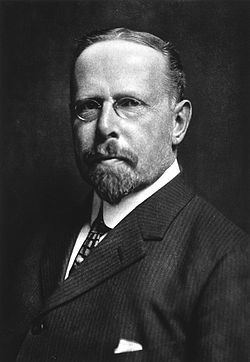Nationality American Education Harvard University | Name Bernard Sachs | |
 | ||
Spouse Bertha Stein (w. 1940)Rosetta Kaskel Books The Normal Child and how to Keep it Normal in Mind & Morals: Suggestions for Parents, Teachers and Physicians; with a Consideration of the Influence of Psychoanalysis | ||
Bernard Sachs (January 2, 1858 – February 8, 1944) was a Jewish-American neurologist.
Contents
Early life and education
After graduating with a B.A. from Harvard in 1878, Sachs travelled to Europe and studied under some of the more prominent physicians of the time, such as Adolf Kussmaul (1822–1902), Friedrich Daniel von Recklinghausen (1833–1910), Friedrich Goltz (1834–1902), Rudolf Virchow (1821–1902), Karl Friedrich Otto Westphal (1833–1890), Theodor Meynert (1833–1892), Jean-Martin Charcot (1825–1893), and John Hughlings Jackson (1835–1911). Later, in 1885, Sachs translated Meynert's classic treatise Psychiatrie into English.
Career
After returning to the United States, he settled into a private practice in New York, and became one of America's leading clinical neurologists. He was an instructor at New York Polyclinic Hospital, and a consultant at Mount Sinai Hospital and Manhattan State Hospital. In addition, he was publisher of the Journal of Nervous and Mental Disease (1886–1911) and president of the American Neurological Association (1894 and 1932).
The condition known as Tay–Sachs disease is named after Sachs along with English ophthalmologist Warren Tay (1843–1927). Tay first described the red spot on the retina of the eye in 1881, while Sachs provided a more comprehensive description of the disease, and in 1887 noted its higher occurrence in Ashkenazi Jews from Eastern Europe.
Sachs published several books, including Nervous and Mental Disorders from Birth through Adolescence, a reference work intended for professionals. In 1926 he published The Normal Child, a popular manual on child rearing intended for the general public. In the latter book he advocated a common-sense approach to parenting and the rejection of psychological theories, especially Freudian psychology.
Personal life
His portrait was painted in the winter of 1914–15 by the Swiss-born American artist Adolfo Muller-Ury (1862–1947), but is presently unlocated.
Sachs, of the notable Goldman–Sachs family, is the son of Joseph Sachs and Sophia Baer. His older brother Samuel Sachs was a co-founder of Goldman Sachs. His eldest brother Julius Sachs was a notable educator at Columbia University and founded Sachs Collegiate Institute. His nephew, Ernest Sachs (1879–1958), also became a notable physician.
